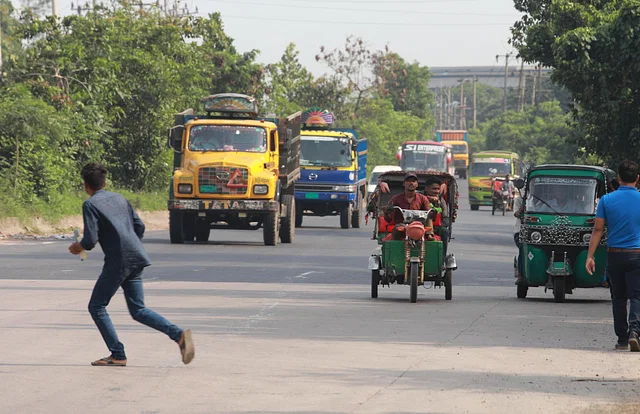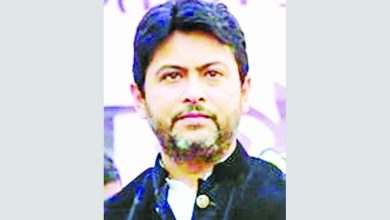National Safe Road Day: Pedestrian deaths higher on Dhaka roads

Dhaka is currently the most dangerous city in the country for pedestrians, with one-fourth of the annual road accident-related fatalities occurring among pedestrians. Over the past three years, both the number of accidents and deaths in Dhaka have seen a significant and alarming increase, with pedestrians being the primary victims.
Dhaka’s road infrastructure is already insufficient to meet the growing demands. The availability of walkways or footpaths falls far short of what is needed. The total length of roads in Dhaka North and South City is just a little over 2,000 kilometres, whereas there are only about 600 km of footpaths. Furthermore, many of the existing sidewalks are unusable.
Experts specialising in road safety have pointed out that Dhaka’s roads are far from being pedestrian-friendly. Many of the footpaths have also been illegally encroached upon, compelling pedestrians to walk on the main road. Additionally, a lack of awareness among pedestrians is another contributing factor to the problem. Furthermore, the absence of a modern signaling system on the roads forces pedestrians to take risks when crossing intersections, resulting in a high rate of pedestrian fatalities in traffic accidents in Dhaka.
Frequent incidents of people being hit by buses and other vehicles while crossing the road are unfortunately common in Dhaka city. One such tragic incident occurred on 24 November, 2021, when Naeem Hasan, a student at Notre Dame College, lost his life after being hit by a garbage truck from the Dhaka South City Corporation while crossing the road in Gulistan.
His father, Shah Alam, expressed his concern over the phone, emphasising the widespread disregard for traffic rules visible on the streets. He also lamented the apparent lack of government action, calling for, at the very least, the government to ensure strict adherence to road rules and regulations.
According to the Road Safety Foundation, an organisation dedicated to improving road safety, 183 people lost their lives in accidents in Dhaka city during the nine-month period from January to September of this year. The highest number of fatalities, 29 in total, occurred in July. Over the past three years, 26 per cent of the individuals killed in road accidents were pedestrians. Dhaka stands out with the highest number of pedestrian fatalities in comparison to other cities in the country.
Experts working in the field of road safety contend that traffic in Dhaka is primarily managed manually by the traffic police, while pedestrians often navigate through the gaps between vehicles. They argue that by implementing pedestrian-friendly modern crossings, people could safely cross the roads on their own.
In this context, Professor Hadiuzzaman, the former director of the Accident Research Institute at Bangladesh University of Engineering and Technology (BUET), conveyed to Prothom Alo that pedestrians are prioritised in modern, smart cities. However, Dhaka lacks pedestrian-friendly infrastructure, making pedestrians particularly vulnerable in this city. He emphasised the importance of implementing a traffic signal system for pedestrian crossings.
In response to this issue, ‘National Safe Road Day’ is commemorated nationwide on 22 October. Since 2017, the day has aimed to raise awareness about road safety through various events. This year’s theme for the day is ‘Let us follow the law on the road and build a smart Bangladesh.’
Experts specialising in road safety stress that merely discussing the law without implementing intelligent traffic management will not lead to significant changes. The traffic management in the capital is entirely manual, making the concept of ‘smart’ in the theme incongruent with the current situation.
Risks for pedestrians
Experts from BUET’s Accident Research Institute have identified several specific reasons for the high number of pedestrian deaths on Dhaka’s roads. Firstly, vehicles often get stuck in traffic for extended periods at key road junctions, leading to a competition to proceed once the traffic signal turns green. With no separate signal system for pedestrian crossings, many individuals attempt to cross the road during this time, increasing the risk of accidents.
Secondly, pedestrians standing on the road can become victims of accidents during the competition between two buses to pick up passengers. Thirdly, due to the inadequate condition of footpaths, many pedestrians are compelled to walk on the road, resulting in accidents as well. Fourthly, heavy goods vehicles in Dhaka often travel at reckless speeds during the night, posing an additional risk of pedestrian fatalities.
Automatic signal systems have not been introduced in Dhaka, not only at pedestrian crossings but city-wide. The entire city’s traffic is currently being manually controlled by the hand signals of the police. Over the past two decades, several projects aimed at implementing modern traffic signals in Dhaka have been executed, with approximately Tk 1.9 billion invested in these initiatives. Unfortunately, most of the signal lamps have become non-functional due to a lack of maintenance and usage.
In the last fiscal year of 2010-11, with financing from the World Bank, solar panels, timer countdowns, controllers, and cables were installed at 92 intersections under Dhaka’s two city corporations. Regrettably, this automatic signal system is now also in disrepair.
Along with two photographers, conducted a four-day investigation into traffic management in various areas of Dhaka city, including Paltan, Shahbagh, Karwan Bazar, Farmgate, Asadgate, and Banani, from Wednesday to Saturday. It was seen that the signal lamps were not functioning at all. In some locations, the signal lights were broken and abandoned, with neither the traffic police nor the drivers paying any attention to these lights. Vehicles were relying on hand signals provided by traffic police for guidance on when to move or stop.
Munibur Rahman, the Additional Commissioner of Traffic for Dhaka Metropolitan Police, informed that several coordination meetings have taken place in recent months involving the two city corporations of Dhaka, BRTA, and the Ministry of Home Affairs regarding traffic management. A decision will be made in the coming months concerning the implementation of a modern traffic signal system.



